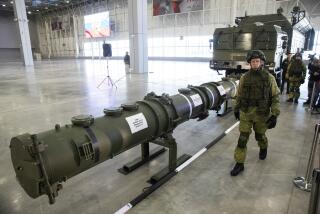Decoupling Dubious Arguments Against Arms-Control Agreement
- Share via
WASHINGTON — The developing agreement between President Ronald Reagan and Soviet leader Mikhail S. Gorbachev to remove from Europe all intermediate nuclear missiles--short-range (300-600 miles) and medium-range (600-3,000 miles)--has recently come under strong attack. Richard M. Nixon, Henry A. Kissinger and Jeane J. Kirkpatrick have warned that removal of these missiles by both sides would significantly reduce nuclear deterrence and leave Western Europe open to attack from vastly superior Soviet conventional forces.
The essence of the argument against the proposed agreement is that without intermediate missiles in Europe the United States would not have a credible nuclear deterrent against a Soviet conventional attack on the North Atlantic Treaty Organization. The chain of reasoning presumably runs as follows: The Europeans believe that the Soviets believe that the United States believes that if the city of Kiev were severely damaged by an intermediate-range Pershing 2 missile launched by the United States from Europe, Soviet leaders would retaliate only against Europe. But if the same city were destroyed to the same degree by a U.S.-launched “strategic” missile from a Polaris sub sitting off the coast of France the Soviets would retaliate against the continental United States. As a consequence, the United States would be loathe to use its Polaris missiles to counter a Soviet invasion of Europe. Believing the United States to hold this view, the Soviets would be deterred from conventional aggression by Pershing 2 missiles on the land mass of Europe but would not be so deterred by Polaris missiles off the European coast.
Only when one sets it down on paper does this argument’s specious nature become clear. It implies that what counts in the Soviet mind in deciding how to retaliate against a nuclear attack is not what target was hit or what damage the missile did or even what the politico-military situation was, but only whether the delivery system was labeled “strategic” or “intermediate.”
This flies in the face of repeated Soviet warnings that they will make no such nice distinctions. The argument has the intellectual ring of a theological debate at the University of Paris circa AD 1250. (One can imagine fascinating discussions on whether, for purposes of deciding where to retaliate, the Soviets would count a B-1 bomber taking off from Dyess Air Force Base in Texas the same as a B-1 taking off from Norway or whether a fueling stop in England would convert a strategic to an intermediate delivery vehicle.)
It was only recently that the United States had any medium-range missiles in Europe. The Pershing 2s have just been deployed, supposedly in response to the Soviet’s SS-20s. The NATO forces have always been distinctly inferior in short-range missiles and until now no one has shown much interest in acquiring them. Are opponents of the proposed agreement trying to tell us they have just discovered that during the 1970s, NATO lacked a credible nuclear deterrent against a Soviet conventional attack and was--without realizing it--effectively decoupled from the U.S. nuclear shield?
The arguments against an intermediate-range nuclear missile agreement also exaggerate the magnitude and military consequences of Soviet conventional superiority in Europe. Yes, the Soviets have more divisions--but their divisions are smaller and less well-equipped. Yes, they have Warsaw Pact allies, but if you were a Soviet general how would you like to attack westward with a Polish army at your back? Yes, they have more tanks and planes. But ours are of superior quality. If they are not, then we need a complete overhaul of our weapons acquisition strategy. In fact, if our weapons are not far superior to the Soviets’ we ought to court-martial a whole generation of military leaders who have convinced the American people to spend from two to 10 times as much per plane, gun and tank as the Soviets, precisely because it would buy us proportionately more effective firepower. And presumably Soviet generals have learned the same basic military principles as everyone else, that an attacker will need roughly a 3-1 numerical advantage over an equally well-armed defender to be reasonably confident of success. As the London-based Institute for Strategic Studies has repeatedly found, neither NATO nor the Warsaw Pact has the kind of edge that would warrant launching an attack. NATO has a substantial, even if not fully sufficient, conventional deterrent in place.
Another argument against the agreement has been raised by Les Aspin (D-Wis.), chairman of the House Armed Services Committee. He complains that the developing Reagan-Gorbachev agreement would attack the “wrong” problem. It is the thousands of battlefield nuclear weapons scattered throughout Europe that pose the greatest threat, since it would be extremely difficult to avoid the escalation of their use in chaotic wartime conditions. Aspin is right that here lies a major threat. But getting rid of medium- and short-range missiles does not preclude a further agreement for a mutual reduction of battlefield nuclear weapons. Gorbachev told Secretary of State George P. Shultz just last month that he was prepared to enter into such negotiations. Just because we will “only” win a BMW instead of a Mercedes does not mean we should get out of the game (especially if we will get another crack at winning the Mercedes later on).
The chances of avoiding war will indeed be served by retaining some nuclear deterrent against a Soviet conventional attack in Europe. It would make sense to strengthen NATO’s conventional forces--a move that could be partly financed by scaling back such strategic monstrosities as the Strategic Defense Initiative and the MX missile. And the world will, of course, be better off if we can negotiate an agreement with the Soviets to cut back on battlefield nuclear weapons. But none of these objectives would be frustrated by a Reagan-Gorbachev agreement on intermediate nuclear missiles as currently outlined.
Reagan has used the Pershing 2s with great success as a bargaining chip to bring the Soviets close to a major agreement on elimination of intermediate-range nuclear missiles from Europe. He should get bipartisan support for the completion of this achievement. The task now at hand is not to carp at what he has accomplished. Rather it is to convince him that while SDI would make another marvelous bargaining chip for strategic disarmament, it would be a terribly dangerous addition to the nation’s strategic inventory.
More to Read
Sign up for Essential California
The most important California stories and recommendations in your inbox every morning.
You may occasionally receive promotional content from the Los Angeles Times.










